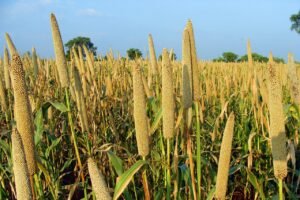With a growing emphasis on health and nutrition, it comes as no surprise that people are constantly searching for new and beneficial ingredients to incorporate into their diets. One such ingredient that has been gaining popularity in recent years is millet. Packed with essential nutrients and boasting an impressive array of health benefits, millet is a grain that deserves the attention of health-conscious individuals. Here, we will explore what the super food millet is, its various types, its nutritional profile, and how it can be incorporated into a healthy and delicious diet.
What is Millet?
Millet is a group of small-seeded grasses that have been cultivated for thousands of years as a staple food in many parts of the world. Believed to have originated in Africa and Asia, and today it is widely grown and consumed in countries like India, China, and Nigeria. The most common types of millet include pearl millet, foxtail millet, finger millet, and proso millet. Each type has its own unique flavor and culinary uses.
Nutritional Benefits of Millet:
Millet is a nutritional powerhouse, packed with a wide range of essential nutrients. It is an excellent source of dietary fiber, which aids in digestion and helps maintain a healthy weight. Additionally, it is rich in vitamins and minerals such as magnesium, phosphorus, and iron, which play vital roles in supporting overall health. Furthermore, millet is gluten-free, making it a suitable grain for those with gluten sensitivities or celiac disease.
Health Benefits:
Consumption of millet has been linked to numerous health benefits. Its high fiber content promotes healthy digestion and can help prevent constipation. The magnesium in millet has been associated with a reduced risk of heart disease and improved heart health. Moreover, millet has a low glycemic index, which means it releases glucose into the bloodstream slowly, making it a suitable grain for individuals with diabetes or those aiming to manage their blood sugar levels.
Incorporating into Your Diet:
Now that we understand the nutritional and health benefits of millet, let’s explore how it can be incorporated into a balanced diet. This can be cooked and enjoyed in various ways. It can be used as a substitute for rice in pilafs, added to soups and stews for a nutritious boost, or ground into flour for baking bread and muffins. Toasting millet before cooking enhances its nutty flavor and adds a delightful crunch to salads and side dishes. The versatility of millet makes it an ideal ingredient for both savory and sweet recipes.
Millet is a versatile and nutritious grain that offers a multitude of health benefits. Its rich nutrient profile, gluten-free nature, and potential for various culinary applications make it an excellent addition to a well-rounded diet. Whether you are looking to improve your digestive health, support heart function, or simply diversify your meals, millet is a fantastic choice. So, why not give this marvelous grain a try and reap the rewards of its wholesome goodness? Embrace the wonders of this super food and embark on a journey toward a healthier, more vibrant lifestyle!
How to cook?
Cooking millet can be an intimidating task for many home cooks, but with the right techniques and a bit of practice, you can create delicious and nutritious meals with this versatile grain. In this comprehensive guide, we will walk you through the step-by-step process of cooking millet to perfection. From rinsing and toasting to simmering and fluffing, you’ll learn the secrets to achieving fluffy, flavorful millet every time.
Preparing for Cooking:
Before you begin cooking millet, it’s important to prepare it properly. Start by measuring the desired amount and then rinse it under cold water in a fine-mesh sieve. This step removes any debris or impurities that may be present. Once rinsed, transfer the millet to a dry skillet over medium heat. Toast the millet for a few minutes until it becomes fragrant and lightly golden, stirring occasionally to prevent burning.
Cooking on the Stovetop:
Once it is toasted, it’s time to cook it on the stovetop. In a saucepan, combine the toasted millet with water or broth using a ratio of 2 cups of liquid to 1 cup of millet. Add a pinch of salt for flavor. Bring the mixture to a boil, then reduce the heat to low and cover the saucepan with a tight-fitting lid. Allow it to simmer gently for about 15-20 minutes or until all the liquid is absorbed.
Fluffing and Serving Millet:
After the millet has absorbed all the liquid and is tender, remove it from the heat and let it sit, covered, for 5 minutes. This resting time allows the millet to steam and becomes even fluffier. Once the resting time is up, remove the lid and fluff it with a fork, gently separating the grains. Serve the cooked millet as a side dish, as a base for stir-fries or salads, or incorporate it into various recipes as desired.
Tips and Variations:
- For added flavor, you can toast the millet with a little oil or butter before adding the liquid.
- Experiment with different liquids, such as vegetable or chicken broth, to enhance the taste.
- Add herbs and spices, such as thyme, rosemary, or cumin, to the cooking liquid for extra aroma and flavor.
- If you prefer a softer texture, increase the liquid-to-millet ratio slightly and cook for a few minutes longer.
- Leftover cooked millet can be stored in an airtight container in the refrigerator for up to 5 days.
With the right techniques and a little creativity, you can transform this humble grain into a delectable and nutritious addition to your meals. By following the steps outlined in this guide, you’ll achieve perfectly cooked millet with fluffy grains and a delightful nutty flavor. So, unleash your culinary prowess, and start incorporating millet into your cooking repertoire. Whether as a side dish, in salads, or as a hearty main course, millet will add a wholesome touch to your culinary creations.
Is millet gluten-free
In recent years, the gluten-free diet has gained significant popularity among health-conscious individuals, leading to increased interest in gluten-free grains. It is a nutrient-dense grain with a rich history, is often inquired about regarding its gluten content.
Understanding Gluten and its Implications:
Gluten is a group of proteins found in wheat, barley, and rye. For individuals with celiac disease or gluten sensitivity, consuming gluten can trigger adverse reactions, leading to digestive discomfort and other health issues. Consequently, it is crucial to identify gluten-free grains to maintain a healthy and symptom-free lifestyle.
The good news is that millet is naturally gluten-free, making it a suitable choice for those following a gluten-free diet. It is a seed grain, not related to wheat or other gluten-containing grains. Its gluten-free status offers a plethora of options for individuals with celiac disease or gluten sensitivity.
Certified Gluten-Free Millet:
While millet is inherently gluten-free, cross-contamination can occur during processing and packaging, compromising its gluten-free status. To ensure what you purchase is truly gluten-free, look for certified gluten-free labels or brands that follow rigorous manufacturing practices and regularly test for gluten presence.
Benefits of Millet for Gluten-Free Diets:
Incorporating millet into a gluten-free diet can provide several benefits. Firstly, it is highly nutritious, packed with essential vitamins, minerals, and dietary fiber. It offers a wholesome alternative to gluten-containing grains, contributing to a well-rounded diet. Secondly, it’s versatility allows for diverse culinary applications, from pilafs and salads to porridges and baked goods.
Cooking with Gluten-Free Millet:
Cooking millet is a simple process that can be enjoyed by anyone, regardless of dietary restrictions. Rinse the millet thoroughly, then combine it with water or broth in a saucepan. Bring it to a boil, reduce the heat, cover, and simmer until the liquid is absorbed. Fluff the cooked millet with a fork and serve it as a side dish or use it as an ingredient in various recipes.
Final Thoughts:
Millet is indeed gluten-free, making it a fantastic option for individuals who need to avoid gluten in their diet. By understanding the nature of gluten and the gluten-free status of millet, those with celiac disease or gluten sensitivity can confidently incorporate this nutritious grain into their meals. Remember to choose certified gluten-free millet to ensure the absence of cross-contamination. Embrace the culinary possibilities that gluten-free millet offers and embark on a journey to a healthier, gluten-free lifestyle.
What is millet used for
A humble grain with a rich history, has gained considerable popularity in recent years due to its nutritional benefits and culinary versatility. In this article, we will delve into the various uses of millet, shedding light on its applications in the US context and providing inspiration for incorporating this grain into your daily meals.
As a Staple Food:
In many parts of the world, millet has long been a staple food. It serves as a primary ingredient in traditional dishes, such as flatbreads, porridges, and pilafs. Its mild flavor and slightly nutty taste make it a versatile base for creating both savory and sweet dishes.
As a Gluten-Free Alternative:
One of the standout features of millet is its gluten-free nature, making it an excellent substitute for gluten-containing grains. Millet flour can be used in baking, giving rise to delectable gluten-free bread, muffins, and cookies. It is a light texture and mild taste complement a variety of recipes.
In Salads and Side Dishes:
Millet’s small, round grains add delightful texture and nuttiness to salads and side dishes. Cooked millet can be tossed with fresh vegetables, herbs, and dressing to create vibrant and nutritious salads. It can also be used as a base for grain bowls or served as a flavorful side dish alongside proteins and vegetables.
In Soups and Stews:
The hearty and absorbent nature of millet makes it an excellent addition to soups and stews. As it cooks, millet releases starch, thickening the broth and imparting a creamy consistency. Add millet to vegetable, chicken, or lentil soups to enhance their texture and boost their nutritional value.
In Breakfast Dishes:
Start your day with a nutritious and energizing breakfast by incorporating millet into your morning routine. Millet porridge, similar to oatmeal, can be cooked with milk or water and flavored with spices, fruits, and nuts. It provides a satisfying and nourishing start to your day.
As a Gluten-Free Flour:
Millet flour is a versatile ingredient for gluten-free baking. It can be used as a standalone flour or combined with other gluten-free flour to create bread, pancakes, and pastries. Experiment with different ratios and recipes to achieve the desired texture and taste.
As a Thickening Agent:
Due to its starch content, millet can be used as a natural thickening agent in sauces, gravies, and casseroles. By simmering millet in liquid and blending it, you can create a smooth and creamy base for your favorite dishes.
In Veggie Burgers and Meatballs:
Millet’s texture and binding properties make it an ideal component in vegetarian or vegan burgers and meatballs. Combine cooked millet with vegetables, legumes, and spices to create delicious and protein-rich alternatives to traditional meat-based dishes.
In Baked Goods:
Expand your baking horizons by incorporating millet into your favorite baked goods. Millet grains can be added to bread dough or sprinkled on top of rolls and loaves for added crunch. Millet flour can be used as a substitute in recipes that call for wheat or other gluten-containing flour.
Takeaway:
Millet is a versatile grain with a wide range of culinary uses. From being a staple food in traditional dishes to serving as a gluten-free alternative in baking, millet offers numerous possibilities for creative and nutritious meals. Explore its potential in salads, soups, breakfast dishes, and even as a thickening agent. Embrace the diverse applications of millet and let your culinary imagination run wild. With millet as your ally, you can create wholesome and delicious meals that cater to your dietary needs and preferences.
Read more wellness and fitness articles here




